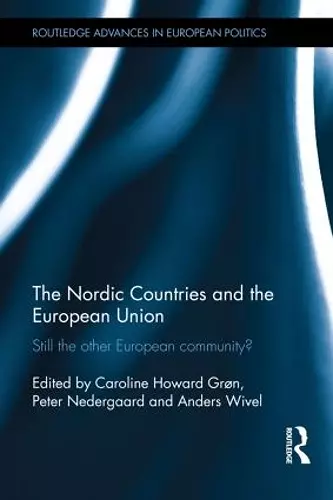The Nordic Countries and the European Union
Still the other European community?
Peter Nedergaard editor Anders Wivel editor Caroline Howard Grøn editor
Format:Hardback
Publisher:Taylor & Francis Ltd
Published:23rd Feb '15
Currently unavailable, and unfortunately no date known when it will be back
This hardback is available in another edition too:
- Paperback£49.99(9781138238381)

In European policy-making, the Nordic countries are often viewed as a relatively coherent bloc; in international and European affairs the Nordic position has traditionally been conditioned on being different from and better than Europe.
This book offers a coherent, original and systematic comparative analysis of the relationship between the Nordic countries and the European Union over the past two decades. It looks at the historical frame, institutions and policy areas, addressing both traditional EU areas such as agriculture and more nascent areas affecting the domestic and foreign policies of the Nordic countries. In doing so, it examines how the Nordic approach to European policy-making has developed and explains why the Nordic countries are similar in some respects while differing in others when engaging with EU institutions. In highlighting the similarities and differences between the Nordic countries it explores what lessons – positive and negative – may be drawn from this approach for the Nordic countries and other small states.
This book will be of interest to scholars, students and practitioners engaged with the Nordic Countries, EU politics and policy-making, European politics and comparative politics.
Revecca Pedi,University of Macedonia
'Authors in this anthology explore the relationship between the five Nordic countries and the European Union. They seek to identify the factors that have determined the behaviour and the performance of these states in European policy-making and to see to what extent the Nordic countries form a distinct community in their relationship with the EU.
The main argument of the book is that the Nordic countries have followed a ‘yes, but …’ approach towards European integration. Moreover, it suggests that they form a cluster rather than a unique and united community, while ‘path dependency’ is prevalent among the factors that influence their choices.
Of course, this is not the first time that Nordic states are presented under this spectrum: on the one hand, being pragmatic and harnessing opportunities, yet on the other, remaining reluctant, preserving national policies, interests and values. However, this volume is innovative and noteworthy in many aspects.
First, it is up to date. Second, it is comprehensive. The authors provide extensive coverage of the relationship between the Nordic countries and the EU, initially shedding light on its historical evolution and then exploring it within the EU institutions context. Finally, they examine it across different policy areas. The book offers a comparative analysis which is anchored to institutionalism in terms of theory and also based on a continuum from changeable to unchangeable factors that impact on the Nordic countries’ choices. The authors employ a historical approach, theoretical analysis and current empirical reasoning in tandem and thus provide those who are familiar with the Nordic and/or Small State and/or EU integration literature with a thought-provoking overview and others, less acquainted with this background, with a very informative book.
From its very beginning, the European integration project has posed a series of challenges and opportunities to all Small States. Following the Lisbon Treaty and the global economic crisis, challenges have been intensified. Different Small States have responded in different ways. Small State scholars have sought to find differences and similarities among them. Against this background, in recent years, studies on Small States and EU integration are increasing and constitute probably the larger part of Small State studies. This work contributes to this literature in a unique and much-needed way. Small State studies usually lack such a concurrence of comparative perspective, comprehensive analysis and coherence. Therefore, this volume is one of the very few attempts within the Small State studies field that aims at a systematic exploration of Small State behaviour. It constitutes, hence, a good starting point for reflecting upon a necessary reform in Small State studies.' © The Author(s) 2016
ISBN: 9781138024243
Dimensions: unknown
Weight: 566g
318 pages